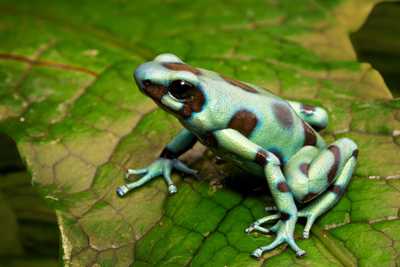Eyelash Viper (Bothriechis schlegelii)
Panama's Reptiles and Amphibians

Operations Manager
17th June 2020
Join us, as we go in search of the incredible reptiles and amphibians of Panama. Staying at the magnificent Canopy Tower, one of the most unique and famous field lodges in the world, this tour is suitable for every person, whether you are an experienced herpetologist or, equally, this is for anyone wanting to enjoy a wonderful cross section of Panama’s wildlife.
In lush Panamanian forests, rich in spectacular floral and faunal biodiversity, a species which can easily fit in the palm of your hand hops along the forest floor searching attentively for tiny insects to feed on - a Poison Arrow Frog. This family of creatures, which have speciated spectacularly into every colour of the rainbow, are notoriously fantastic parents. In Panama, parent Green-and-black Poison Arrow Frogs carefully move their tadpoles between water bodies, locating the best water quality for their offspring to thrive. Also calling this region home, Vicente’s Poison Arrow Frog goes a step further in their parental care; the mother deposits special nutritive eggs into her natal pool for their tadpoles to feed on, earning the species its scientific name of Oophaga, which means ‘egg-eating’.

Panama – Reptiles and Amphibians
Tree frogs here in Panama adopt a different strategy in their colouration. Rather than dazzling predators with vivid colours to advertise that they’re poisonous, tree frogs are largely camouflaged. One group have advanced their camouflage to a new level; they are largely transparent – and thus are called the ‘glass frogs’. These fragile and otherwise defenceless beauties also have an interesting reproductive strategy for success – they lay their eggs on the undersides of leaves that overhang water sources. The tadpoles, still developing inside the egg, can sense would-be predators and are capable of hatching prematurely and dropping into the water, taking their chances in the pools and streams, away from terrestrial and arboreal predators.

Canopy Tower

Green-and-black Poison Frog

Red-eyed Tree Frog
Amongst mossy-green boulders and fallen logs in these forests, female Yellow-spotted Night Lizards are capable of reproducing without males by cloning themselves, a phenomenon known as parthenogenesis, a real rarity in reptiles, especially those on the mainland. This lizard is also fascinatingly unusual in that it gives birth to live young, an adaption normally reserved for reptiles living in cold climates.
Dwarf geckos in the family Sphaerodactylus sometimes occur at a density of over 21,000 individuals per acre, equating to a biomass of about nine pounds per acre. In fact, their population density in terms of biomass is similar to that of the African Elephant! Panama’s tropical forests are home to the beautiful Caribbean Least Gecko, which we are sure to see scurrying amongst the leaf litter, providing a chance to appreciate these remarkable, miniature, animals up-close.
With our expert herpetologist guide we have the chance to build an enviable list of reptile and amphibians, with highlights that could include Rainbow Lizard, Eyelash Viper, Meso-American Slider Turtle, Helmeted Iguana, Panamanian Coral Snake, Reticulated Glass Frog, Rosenberg’s Gladiator Tree Frog and Panama Humming Frog.

Eyelash Viper

Reticulated Glass Frog

Rainbow Lizard
The botanically-rich forests in this area are home to numerous stunning plants, from colourful bromeliads to fragrant orchids, and we’ll find out about many interesting mutual relationships between plants, reptiles and amphibians. Panamanian rainforests are also bird and mammal-rich and between finding reptiles and amphibians we will be sure to enjoy some of the wonderful birdlife here, including trogons, motmots, jacamars and hummingbirds, plus neotropical mammals including Brown-throated and Hoffman’s Two-toed Sloths, Geoffroy’s Tamarin and Northern Tamandua. Furthermore, we’ll also have the chance to explore the forest at night, in search of nocturnal reptiles and amphibians, with the chance of some real mammal specialities like the endemic and wonderful Rothschild's Porcupine and the beautiful Bushy-tailed Olingo.

Keel-billed Toucan

Brown-throated Three-toed Sloth




 Loading search...
Loading search...